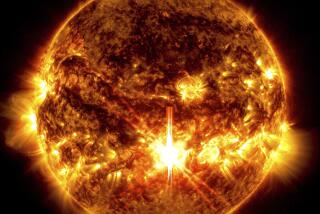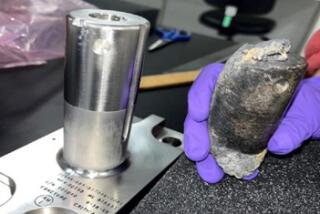Fireball seen passing over Southern California is identified as Russian space junk
Southern Californians marveled Tuesday night at what appeared to be a bright fireball streaking across the evening sky.
Was it a comet? Perhaps a particularly showy member of the Ursids meteor shower?
Hardly. It was just a piece of Russian space junk.
The flashy mystery object was in fact a Russian SL-4 rocket body that had fallen from orbit to its blazing doom. But the event was no surprise, military officials said.
“This was an object that we were tracking and we knew was going to come and reenter the atmosphere,” said Maj. Matt Miller, a spokesman for U.S. Strategic Command.
Space junk is not uncommon, officials said. Humans leave a sizable footprint on the planet. In orbit, it takes the shape of used-up rocket stages, dead satellites and the occasional tool that got away from a space-walking astronaut.
Some 16,000 man-made objects orbiting Earth are currently tracked by the Joint Space Operations Center, according to the Strategic Command. About 5% of those objects are working satellites or other payloads, some 8% are discarded rocket bodies, and the vast majority — about 87% — are inactive satellites or other debris.
“There are millions of small bits of space junk in orbit about the Earth,” said Don Yeomans, manager for NASA’s Near-Earth Object Program Office at the Jet Propulsion Laboratory in La Cañada Flintridge.
That includes about 100 million pieces that measure no more than 1 centimeter, he said.
It may sound like a lot of junk, but at any given size, the number of artificial bodies that enter the atmosphere is lower than the number of natural ones, Yeomans said.
Space debris, both man-made and natural, bombards the Earth on a regular basis, Miller said. We just don’t happen to see most of it.
For one thing, the ability to see it depends on the basic viewing conditions — whether it’s daytime or nighttime, and whether there are clouds obscuring the show.
This particular bit of space junk was on the larger side, with a radar cross-section approximately 10 meters square, according to Capt. Nicholas Mercurio, a spokesman for the Joint Functional Component Command for Space, which runs the Joint Space Operations Center.
The speeding object was spotted from as far away as Ventura and Las Vegas, and viewers said it lit up the sky for 10 to 20 seconds.
“The fireball event of last night was unusually large and long-lasting,” Yeomans said. “Rocket boosters can cause these large fireballs, but the vast majority of man-made objects causing fireballs are about centimeter-sized.”
Join the conversation on Facebook >>
Though it caused quite a bit of consternation, the danger posed by these kinds of objects is exceedingly slim, experts said.
“When an object reenters the atmosphere, a majority of the time — a large majority of the time — it burns up in the atmosphere,” Miller said. “There is also a considerable percentage that ... reenters over an ocean.”
As a result, he said, “the number of objects actually recovered is very, very small.”
Some 109 bits of known space debris have fallen from orbit this year, Mercurio said. But those who track space junk can’t say for certain how all of these objects met their fate.
“There’s really no way for us to track it once it enters the atmosphere,” Mercurio said.
Twitter: @aminawrite







